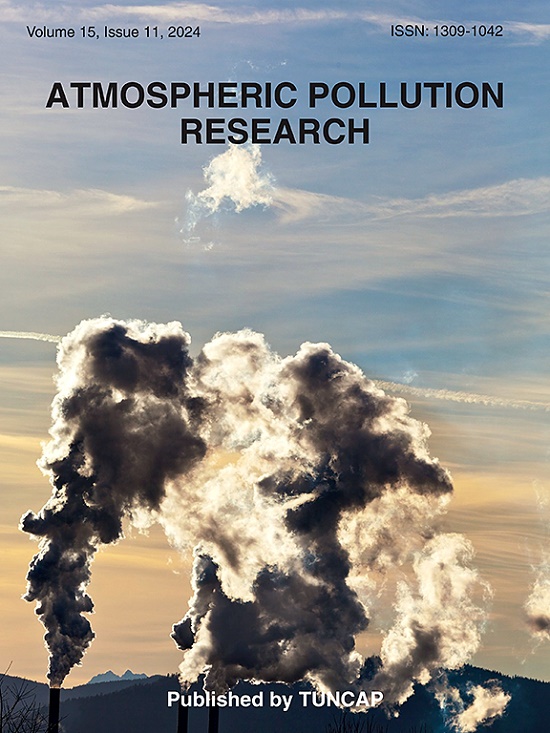基于卫星遥感的巴基斯坦上空对流层甲醛的时空变化及其潜在来源
IF 3.9
3区 环境科学与生态学
Q2 ENVIRONMENTAL SCIENCES
引用次数: 0
摘要
甲醛(HCHO)是一种危害大气环境和人体健康的微量气体。因此,有必要分析HCHO的空间动态特征、潜在来源和相关健康风险。为此,本研究利用对流层监测仪器(TROPOMI) HCHO观测数据,分析了2019 - 2023年巴基斯坦HCHO的时空变化。此外,还利用潜在源贡献函数(PSCF)和浓度加权轨迹(CWT)技术确定了HCHO的潜在源区域。结果表明,巴基斯坦的年平均HCHO浓度从114 μmol/m2(2019年)增加到117 μmol/m2(2023年),增长率为0.3%。旁遮普省(177 μmol/m2)、信德省(138 μmol/m2)和KPK省(121 μmol/m2)的HCHO平均浓度高于全国平均水平(105 μmol/m2)。拉合尔、古吉兰瓦拉和白沙瓦是巴基斯坦HCHO排放最多的城市,平均HCHO分别为204.25±18.85 μmol/m2、202.51±8.14 μmol/m2和201.65±13.66 μmol/m2。该研究发现,工业部门是巴基斯坦HCHO排放的主要来源,其次是住宅和交通部门。HCHO与归一化植被指数(NDVI) (R2 = 0.5)和地表温度(LST) (R2 = 0.7)的空间相关性表明,NDVI和LST对HCHO浓度有正向影响。此外,CWT和PSCF分析表明,除了当地排放,来自印度、阿富汗、伊朗和阿拉伯海气流的跨境空气污染也有助于巴基斯坦HCHO的运输。本文章由计算机程序翻译,如有差异,请以英文原文为准。

Spatiotemporal variations of tropospheric formaldehyde and its potential sources over Pakistan based on satellite remote sensing
Formaldehyde (HCHO) is a trace gas that harms the atmospheric environment and human health. Therefore, it is essential to analyze the spatial dynamic characteristics of HCHO, potential sources, and the associated health risks. To do so, the current study utilized the TROPOspheric Monitoring Instrument (TROPOMI) HCHO observations to analyze the spatiotemporal variations of HCHO in Pakistan from 2019 to 2023. Moreover, the potential source areas of HCHO are also identified using the potential source contribution function (PSCF) and concentration-weighted trajectory (CWT) technologies. The results indicate an annual average HCHO concentration increase in Pakistan from 114 μmol/m2 (in 2019) to 117 μmol/m2 (in 2023) with a 0.3% growth rate. The average HCHO concentration in Punjab (177 μmol/m2), Sindh (138 μmol/m2), and KPK (121 μmol/m2) provinces is above the country average (105 μmol/m2). Lahore, Gujranwala, and Peshawar are the top HCHO emitters in Pakistan with mean HCHO of 204.25 ± 18.85 μmol/m2, 202.51 ± 8.14 μmol/m2, and 201.65 ± 13.66 μmol/m2, respectively. The study found the industrial sector as the main contributor to HCHO emissions in Pakistan, followed by the residential and transportation sectors. The findings of the spatial correlation of HCHO with Normalized Difference Vegetation Index (NDVI) (R2 = 0.5) and Land Surface Temperature (LST) (R2 = 0.7) indicate the positive influence of NDVI and LST on HCHO concentration. Moreover, the CWT and PSCF analyses suggest that in addition to local emissions, transboundary air pollution from India, Afghanistan, Iran, and Arabian Sea airflow also contributed to the transport of HCHO in Pakistan.
求助全文
通过发布文献求助,成功后即可免费获取论文全文。
去求助
来源期刊

Atmospheric Pollution Research
ENVIRONMENTAL SCIENCES-
CiteScore
8.30
自引率
6.70%
发文量
256
审稿时长
36 days
期刊介绍:
Atmospheric Pollution Research (APR) is an international journal designed for the publication of articles on air pollution. Papers should present novel experimental results, theory and modeling of air pollution on local, regional, or global scales. Areas covered are research on inorganic, organic, and persistent organic air pollutants, air quality monitoring, air quality management, atmospheric dispersion and transport, air-surface (soil, water, and vegetation) exchange of pollutants, dry and wet deposition, indoor air quality, exposure assessment, health effects, satellite measurements, natural emissions, atmospheric chemistry, greenhouse gases, and effects on climate change.
 求助内容:
求助内容: 应助结果提醒方式:
应助结果提醒方式:


